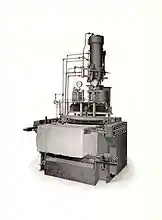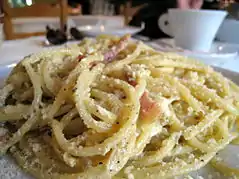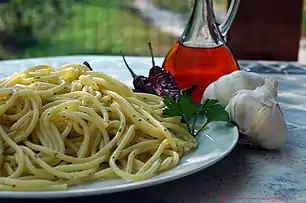 Spaghetti hung to dry | |
| Type | Pasta |
|---|---|
| Place of origin | Italy |
| Main ingredients | Semolina or flour, water |
Spaghetti (Italian: [spaˈɡetti]) is a long, thin, solid, cylindrical pasta.[1] It is a staple food of traditional Italian cuisine. Like other pasta, spaghetti is made of milled wheat, water, and sometimes enriched with vitamins and minerals. Italian spaghetti is typically made from durum-wheat semolina.[2] Usually the pasta is white because refined flour is used, but whole wheat flour may be added. Spaghettoni is a thicker form of spaghetti, while spaghettini is a thinner form. Capellini is a very thin spaghetti, sometimes known colloquially as "angel hair pasta", while Vermicelli refers to intermediate widths, varying between the United States and Italy.
Originally, spaghetti was notably long, but shorter lengths gained in popularity during the latter half of the 20th century and now it is most commonly available in 25–30 cm (10–12 in) lengths. A variety of pasta dishes are based on it and it is frequently served with tomato sauce, meat or vegetables.
Etymology
Spaghetti is the plural form of the Italian word spaghetto, which is a diminutive of spago, meaning 'thin string' or 'twine'.[1]
History
The first written record of pasta comes from the Talmud in the 5th century AD and refers to dried pasta that could be cooked through boiling,[3] which was conveniently portable.[4] Some historians think that Arabs introduced pasta to Europe during a conquest of Sicily. In the West, it may have first been worked into long, thin forms in Sicily around the 12th century, as the Tabula Rogeriana of Muhammad al-Idrisi attested, reporting some traditions about the Sicilian kingdom.[5]
The popularity of spaghetti spread throughout Italy after the establishment of spaghetti factories in the 19th century, enabling the mass production of spaghetti for the Italian market.[6]
In the United States around the end of the 19th century, spaghetti was offered in restaurants as Spaghetti Italienne (which likely consisted of noodles cooked past al dente, and a mild tomato sauce flavored with easily found spices and vegetables such as cloves, bay leaves, and garlic) and it was not until decades later that it came to be commonly prepared with oregano or basil.[7][8][9]
Sparghetti
Circa 1845, Italians used the word "sparghetti" denote the recently invented pasta shape. According to 2013 publication Discovering Words in the Kitchen claims the spelling "showed the derivation of the word to be a diminutive of spargo, meaning 'cord'".[10]
The term "sparghetti" continued to be in use throughout the 19th and early 20th century, in association with both the pasta shape and the recipe. In 1845 British recipe guide Modern Cookery, "Sparghetti" is defined as Naples vermicelli.[11] The same definition appears in Robert Ridell's 1852 Indian Domestic Economy and Receipt Book and its reprints.[12][13]
In the 1880 Housekeeper's Guide, Arthur Gay Payne writes, "When macaroni is served with tomato sauce and Parmesan grated cheese, it forms that very well-known dish called 'sparghetti.' A particular kind of macaroni is specially sold for making sparghetti".[14] An 1896 recipe, reprinted in 1909, clarifies, "Sparghetti is a type of fine macaroni".[15] The spelling "sparghetti" and associated recipe is also described in 1900's Recipe a la Mode,[16] 1901's Recherché Side Dishes,[17] Agnes Marshall's 1902 Larger Cookery book,[18] the 1905 Hints for the Home,[19] Benjamin Farjeon's 1906 fiction novel Mrs. Dimmock's Worries,[20] and 1913's The Treasure Cookery Book.[21]
Its modern term, "spaghetti," was introduced in 1888.[22]
The Great Eastern Railway magazine of 1914 recommends "sparghetti" as an alternative to macaroni in its recipe for "macaroni cheese."[23]
Ingredients
Spaghetti is made from ground grain (flour) and water.[24] Whole-wheat and multigrain spaghetti are also available.[2]
Production
Fresh spaghetti

At its simplest, imitation spaghetti can be formed using no more than a rolling pin and a knife. A home pasta machine simplifies the rolling and makes the cutting more uniform.[25] Although, of course cutting sheets produces pasta with a rectangular rather than a cylindrical cross-section and the result is a variant of fettuccine. Some pasta machines have a spaghetti attachment with circular holes that extrude spaghetti or shaped rollers that form cylindrical noodles.
Spaghetti can be made by hand by manually rolling a ball of dough on a surface to make a long sausage shape. The ends of the sausage are pulled apart to make a long thin sausage. The ends are brought together and the loop pulled to make two long sausages. The process is repeated until the pasta is sufficiently thin. The pasta knobs at each end are cut off leaving many strands which may be hung up to dry.[26]
Fresh spaghetti would normally be cooked within hours of being formed. Commercial versions of fresh spaghetti are manufactured.[27]
Dried spaghetti
The bulk of dried spaghetti is produced in factories using auger extruders. While essentially simple, the process requires attention to detail to ensure that the mixing and kneading of the ingredients produces a homogeneous mix, without air bubbles. The forming dies have to be water cooled to prevent spoiling of the pasta by overheating. Drying of the newly formed spaghetti has to be carefully controlled to prevent strands sticking together, and to leave it with sufficient moisture so that it is not too brittle. Packaging for protection and display has developed from paper wrapping to plastic bags and boxes.[28]
 A hydraulic press with an automatic spreader by the Consolidated Macaroni Machine Corporation, Brooklyn, New York. This machine was the first to spread long cut alimentary paste products onto a drying stick.
A hydraulic press with an automatic spreader by the Consolidated Macaroni Machine Corporation, Brooklyn, New York. This machine was the first to spread long cut alimentary paste products onto a drying stick. An industrial dryer for spaghetti or other long goods pasta products, also by the Consolidated Macaroni Machine Corporation
An industrial dryer for spaghetti or other long goods pasta products, also by the Consolidated Macaroni Machine Corporation Dried spaghetti
Dried spaghetti Dried spaghetti measured with a "spaghetti measure". One portion of dried pasta weighs 116 g (4+1⁄8 oz), twice the amount of one serving on the package (12 mm circle or 60 g.). The measure can portion out 1, 2, 3, or 4 servings based on the diameter of the circle.
Dried spaghetti measured with a "spaghetti measure". One portion of dried pasta weighs 116 g (4+1⁄8 oz), twice the amount of one serving on the package (12 mm circle or 60 g.). The measure can portion out 1, 2, 3, or 4 servings based on the diameter of the circle.
Preparation
Fresh or dry spaghetti is cooked in a large pot of salted, boiling water and then drained in a colander (Italian: scolapasta).
In Italy, spaghetti is generally cooked al dente (Italian for "to the tooth"), fully cooked but still firm to the bite. It may also be cooked to a softer consistency.
Spaghettoni is a thicker spaghetti which takes more time to cook. Spaghettini is a thinner form which takes less time to cook. Capellini is a very thin form of spaghetti (it is also called "angel hair spaghetti" or "angel hair pasta") which cooks very quickly.
Utensils used in spaghetti preparation include the spaghetti scoop and spaghetti tongs.
 Spaghetti being placed into a pot of boiling water for cooking
Spaghetti being placed into a pot of boiling water for cooking Draining the water from boiled spaghetti
Draining the water from boiled spaghetti A spaghetti scoop
A spaghetti scoop Spaghetti tongs
Spaghetti tongs
Serving
Italian cuisine

An emblem of Italian cuisine, spaghetti is frequently served with tomato sauce, which may contain various herbs (especially oregano and basil), olive oil, meat, or vegetables. Other spaghetti preparations include amatriciana or carbonara. Grated hard cheeses, such as pecorino romano, Parmesan and Grana Padano, are often sprinkled on top.
International cuisine
.jpg.webp)
In some countries, spaghetti is sold in cans/tins with sauce.
In the United States, it is sometimes served with Cincinnati chili. Unlike in Italy, in other countries spaghetti is often served with Bolognese sauce.
In the Philippines, a popular variant is the Filipino spaghetti, which is distinctively sweet with the tomato sauce sweetened with banana ketchup or sugar. It typically uses a large amount of giniling (ground meat), sliced hotdogs, and cheese. The dish dates back to the period between the 1940s to the 1960s. During the American Commonwealth Period, a shortage of tomato supplies in the Second World War forced the development of the banana ketchup.[29][30][31] Spaghetti was introduced by the Americans and was tweaked to suit the local Filipino predilection for sweet dishes.[32]
Sapaketti phat khi mao (Spaghetti fried drunken noodle style) is a popular dish in Thai cuisine.[33]
Spaghetti is a main part of laksa Johor, a specialty from Johor, Malaysia.[34]
Spaghetti dishes
- Spaghetti aglio e olio – ("spaghetti with garlic and oil" in Italian), a traditional Italian pasta dish coming from Naples.
- Spaghetti alla puttanesca – (literally "spaghetti whore-style" in Italian), a tangy, somewhat salty Italian pasta dish invented in the mid-20th century. The ingredients are typical of Southern Italian cuisine: tomatoes, olive oil, olives, capers and garlic.[35]
- Spaghetti alla Nerano – from the village of Nerano, near Naples. With fried zucchinis and a local variant of provolone.
- Spaghetti alle vongole – Italian for "spaghetti with clams", it is very popular throughout Italy, especially its central regions, including Rome and further south in Campania (where it is part of traditional Neapolitan cuisine).
- Spaghetti and meatballs – an Italian-American dish that usually consists of spaghetti, tomato sauce and meatballs.
- Spaghetti bolognese – spaghetti with ragù (minced beef and tomato sauce).
- Spaghetti dishes


 Spaghetti cacio e pepe ("cheese and pepper") at a restaurant in Rome
Spaghetti cacio e pepe ("cheese and pepper") at a restaurant in Rome Spaghetti con pollo e funghi
Spaghetti con pollo e funghi Spaghetti pomodoro e basilico ("tomato sauce and basil")
Spaghetti pomodoro e basilico ("tomato sauce and basil")
.jpg.webp)
Consumption
By 1955, annual consumption of spaghetti in Italy doubled from 14 kilograms (31 lb) per person before World War II to 28 kilograms (62 pounds).[36] By that year, Italy produced 1,432,990 tons of spaghetti, of which 74,000 were exported, and had a production capacity of 3 million tons.[36]
Nutrition
| Nutritional value per 70 g (2+1⁄2 oz) | |
|---|---|
| Energy | 460 kJ (110 kcal) |
22g | |
| Sugars | 0g |
| Dietary fiber | 1g |
0.5g | |
| Saturated | 0g |
| Trans | 0g |
4g | |
| Vitamins | Quantity %DV† |
| Vitamin A equiv. | 0% 0 μg |
| Vitamin C | 0% 0 mg |
| Minerals | Quantity %DV† |
| Calcium | 0% 0 mg |
| Iron | 31% 4 mg |
| Sodium | 0% 0 mg |
Source: USDA[37] | |
| |
| †Percentages are roughly approximated using US recommendations for adults. | |
Pasta provides carbohydrates, along with some protein, iron, dietary fiber, potassium and B vitamins.[38] Pasta prepared with whole wheat grain provides more dietary fiber[38] than that prepared with degermed flour.
Records
The world record for the largest bowl of spaghetti was set in March 2009 and reset in March 2010 when a Buca di Beppo restaurant in Garden Grove, California, filled a swimming pool with more than 6,250 kg (13,780 lb) of pasta.[39]
In popular culture
The term "spaghetti Western" was used by American critics and those in other countries because most of the Western movies made in Europe were produced and directed by Italians.[40]
The BBC television program Panorama featured a hoax program about the spaghetti harvest in Switzerland on April Fools' Day, 1957.[41]
The story "Confession publique faite par la dernière mangeuse de spaghettis", from the collection Le Génie de l'aubergine et autres contes loufoques, by Pierre Cormon (1997), features a woman who refuses to give up traditional spaghetti in favour of spaghetti cubes, the latest innovation from the agri-food industry in 2053, and pays a high price for it.
Spaghetti code means badly written code.
See also
References
- 1 2 spaghetti. Dictionary.com. Dictionary.com Unabridged (v 1.1). Random House, Inc. (accessed: 3 June 2008).
- 1 2 "How to Make Spaghetti". Better Homes and Gardens. Retrieved on 22 December 2014.
- ↑ "Pasta is Not Originally from Italy". www.todayifoundout.com. 3 June 2011. Retrieved on 22 December 2014.
- ↑ "History and Origin of Pasta". www.101cookingrecipes.com. Retrieved 16 January 2017.
- ↑ Kummer, Corby (1 July 1986). "Pasta". The Atlantic.
- ↑ Whiteman, Kate; Boggiano, Angela; Wright, Jeni (2007). The Italian kitchen bible. Hermes House. pp. 12–13. ISBN 978-1-84038-875-6.
- ↑ The Settlement Cook Book: Tested Recipes from the Settlement Cooking Classes, the Milwaukee Public School Kitchens, The School of Trades for Girls, and Experienced Housewives. Settlement Cook Book Company. 1921.
- ↑ Mazdaznan encyclopedia of dietetics and home cook book: cooked and uncooked foods, what to eat and how to eat it ... Mazdaznan associates of God. 1909.
- ↑ Levenstein, Harvey (2002). Counihan, Carole M. (ed.). Food in the USA: A Reader. Routledge. pp. 77–89. ISBN 0-415-93232-7.
- ↑ Walker, Julian (20 January 2013). Discovering Words in the Kitchen. Bloomsbury Publishing. ISBN 978-0-7478-0952-4.
- ↑ Acton, Eliza (1845). Modern Cookery ... Illustrated ... Fourth edition. Longman, Brown, Green&Longmans.
- ↑ Riddell, Robert (1852). Indian domestic economy and receipt book ... By the author of "Manual of gardening for Western India" [i.e. R. F. Riddell.] Third edition, revised. Bombay Gazette Press.
- ↑ Riddell, R. (1853). Indian Domestic Economy and Receipt Book: Comprising Numerous Directions for Plain Wholesome Cookery, Both Oriental and English; with Much Miscellaneous Matter Answering for All General Purposes of Reference Connected with Household Affairs, Likely to be Immediately Required by Families, Messes, and Privave [sic] Individuals, Residing at the Presidencies Or Out-stations. Christian Knowledge Society's Press.
- ↑ Senn, Charles Herman (1901). Recherché Side Dishes: For Breakfast, Luncheon, Dinner and Supper Comprising the Newest Hors D'oeuvre, Savouries, Sandwiches & Salads, Oriental Dishes, Etc. Spottiswoode.
- ↑ Coltman), Lady Clark (Charlotte (1909). The Cookery Book of Lady Clark of Tillypronie. Constable.
- ↑ Anne), Mrs De Salis (Harriet (1900). Entrěs ̉la Mode. Longmans, Green.
- ↑ Senn, Charles Herman (1901). Recherché Side Dishes: For Breakfast, Luncheon, Dinner and Supper Comprising the Newest Hors D'oeuvre, Savouries, Sandwiches & Salads, Oriental Dishes, Etc. Spottiswoode.
- ↑ Marshall, Agnes B. (1902). Mrs. A. B. Marshall's Larger Cookery Book of Extra Recipes. Marshall's school of cookery.
- ↑ Ferrier, J. Todd (1905). The Herald of the Cross. Lamley & Company for the Order of the Cross.
- ↑ Farjeon, Benjamin Leopold (1906). Mrs. Dimmock's Worries. Hutchinson.
- ↑ Mitchell, M. M. (1913). The Treasure Cookery Book: Containing the Principles and Rules of Modern Cookery, Including Numerous Recipes. Longmans, Green and Company.
- ↑ Walker, Julian (20 January 2013). Discovering Words in the Kitchen. Bloomsbury Publishing. ISBN 978-0-7478-0952-4.
- ↑ Railway, London and North Eastern (1914). Great Eastern Railway Magazine. Great Eastern Railway Company.
- ↑ Gisslen, Wayne; Griffin, Mary Ellen; Le Cordon Bleu (2006). Professional Cooking for Canadian Chefs. John Wiley & Sons. p. 635. ISBN 0471663778.
- ↑ "Homemade Spaghetti". Instructables.com. 16 October 2008. Retrieved 19 December 2014.
- ↑ Luke Rymarz (24 June 2008). "How To Make Hand-Pulled Noodles: Part 2 of 2, Pulling". YouTube. Archived from the original on 11 December 2021.
- ↑ "Fresh Spaghetti". Metro. 17 April 2023.
- ↑ "Pasta Manufacturing" (PDF). Epa.gov. August 1995. Retrieved 19 December 2014.
- ↑ Halpern, Sue; McKibben, Bill (May 2015). "Filipino Cuisine Was Asian Fusion Before "Asian Fusion" Existed". Smithsonian Magazine. Smithsonian Institution. Retrieved 16 December 2018.
- ↑ "The Origin of the Filipino Style Spaghetti". Juan Carlo. 15 April 2016. Retrieved 16 December 2018.
- ↑ Estrella, Serna (30 July 2014). "The Origins of Sweet Spaghetti: A Closer Look at the Filipino Sweet Tooth". Pepper.ph. Retrieved 16 December 2018.
- ↑ "How to make Sweet Filipino Spaghetti with Meat Sauce". Asian in America. 23 October 2012. Retrieved 16 December 2018.
- ↑ "Drunken Noodles » Real Thai Recipes » Authentic Thai recipes from Thailand". Realthairecipes.com. 12 June 2007. Retrieved 15 September 2018.
- ↑ Durai, Abirame Anne. "Laksa Johor". Kuali. Retrieved 30 January 2022.
- ↑ Zanini De Vita & Fant 2013, p. 68.
- 1 2 Salerno, George (13 December 1956). "Spaghetti consumption up as national dish in Italy". Wilmington Morning Star. Vol. 90, no. 52. Wilmington, North Carolina. United Press.
- ↑ "Spaghetti, Enriched, Dry" (PDF). United States Department of Agriculture. October 2012. Retrieved 16 December 2014.
- 1 2 Ridgwell, Jenny (1996). Examining Food and Nutrition. Heinemann. p. 94. ISBN 0435420585.
- ↑ KTLA News (12 March 2010). "Restaurant Sets World Record with Pool of Spaghetti to be used as animal feed". KTLA. Archived from the original on 18 March 2012.
{{cite news}}: CS1 maint: unfit URL (link) - ↑ Gelten, Simon; Lindberg (10 November 2015). "Introduction". Spaghetti Western Database. Archived from the original on 30 June 2017. Retrieved 2 May 2021.
- ↑ "1957: BBC fools the nation". On This Day. BBC. 1 April 2005.
Bibliography
- Zanini De Vita, Oretta; Fant, Maureen B. (2013). Sauces & Shapes: Pasta the Italian Way. New York: W. W. Norton & Company. ISBN 978-0-393-08243-2.
Further reading
- Butler, Stephanie (12 June 2014). "Spaghetti and Its Sauces". History Channel. Retrieved 16 December 2014.